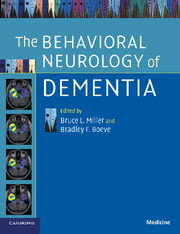Book contents
- Frontmatter
- Contents
- List of contributors
- Section 1 Introduction
- 1 Basic clinical approaches to diagnosis
- 2 Dementia with Lewy bodies
- 3 Neurogenetics of dementia
- 4 Frontotemporal dementia
- 5 Alzheimer's disease
- 6 Mental status examination
- 7 Neuropsychiatric features of dementia
- 8 Neuroimaging in dementia
- 9 Epidemiology and risk factors
- 10 Animal models of dementia
- 11 Neuropathology of dementia
- Section 2 Cognitive impairment, not demented
- Section 3 Slowly progressive dementias
- Section 4 Rapidly progressive dementias
- Index
- References
3 - Neurogenetics of dementia
Published online by Cambridge University Press: 31 July 2009
- Frontmatter
- Contents
- List of contributors
- Section 1 Introduction
- 1 Basic clinical approaches to diagnosis
- 2 Dementia with Lewy bodies
- 3 Neurogenetics of dementia
- 4 Frontotemporal dementia
- 5 Alzheimer's disease
- 6 Mental status examination
- 7 Neuropsychiatric features of dementia
- 8 Neuroimaging in dementia
- 9 Epidemiology and risk factors
- 10 Animal models of dementia
- 11 Neuropathology of dementia
- Section 2 Cognitive impairment, not demented
- Section 3 Slowly progressive dementias
- Section 4 Rapidly progressive dementias
- Index
- References
Summary
The molecular era of human genetics began in 1983 when an intrepid group of clinicians and scientists led by James Gusella and Nancy Wexler mapped the gene mutation that causes Huntington's disease (HD) to the short arm of human chromosome 4. In the 25 years since this discovery, the new field of human neurogenetics has provided an unprecedented explosion in our molecular understanding of dementia. Aided by the “completion” of the Human Genome Project, scientists continue to discover new gene mutations that cause rare but highly penetrant familial dementia syndromes. The study of these genes and the proteins they encode have provided us with plausible hypotheses for the biochemical underpinnings of these rare diseases as well as the more common syndromes to which they are related.
Traditional disease gene discovery has been performed through the processes of “linkage analysis” and “positional cloning.” These methods make no a priori assumptions about the biochemical function of the protein corresponding to the mutant gene but instead rely upon the discovery of the physical location of the mutation on one of the chromosomes. They require the phenotypic characterization of one or more large families through which the disease phenotype segregates. In general, larger families provide more genetic information through the number of meiotic recombination events. Genetic material from each available member of the family is scored for a panel of DNA polymorphisms, or “markers”, spanning each human chromosome.
- Type
- Chapter
- Information
- The Behavioral Neurology of Dementia , pp. 27 - 44Publisher: Cambridge University PressPrint publication year: 2009



